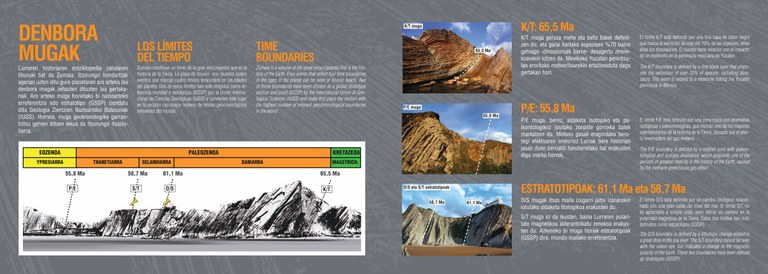In Zumaia, you can read the Earth’s history
In Zumaia, you can see geological time
We can read each page of part of the Earth’s history, and that’s no small matter. That’s why over the past century researchers from around the world have visited our cliffs looking for answers, and they've found them! In 2022, the International Union of Geological Sciences (IUGS) declared Zumaia’s flysch one of the world's 100 top geological treasures.
The Basque Coast Geopark is formed of the municipalities of Zumaia, Deba and Mutriku and is located between the Cantabrian sea and the Basque mountains. Since 2010, it has been a member of the European and Global Geoparks Network and since 2015, it has also been recognised by UNESCO.
This spectacular formation, made up of the rocky layers of the Geopark’s cliffs, is called Flysch. In this space located between Mutriku and Zumaia, layer by layer and page by page we can read more than 60 million years of the Earth’s history. It's like a giant encyclopaedia.
All these layers are formed of sediment and marine fossils. If we placed the layers in their original horizontal position, they would be over 5,000 metres thick. A truly dense book!
In addition to having many pages or layers, we can read them very clearly. Actually, there isn't a single page missing. From the oldest (110 million years ago in Mutriku) to the most recent (around 50 million years ago in Zumaia), we have all the layers exactly as they were formed under the sea.
The years represented in Zumaia’s rocks - between 70 and 50 million years ago - saw episodes take place that were very important for the Earth’s history. For example, 66 million years ago dinosaurs and 70% of the species living on Earth disappeared. This mass extinction was caused by a meteorite impacting Yucatan and is very well recorded in Zumaia's rocks. Specifically, in Algorri.
On the other hand, the intense global warming that happened 56 million years ago can also be read in Zumaia. This warming was also caused by the greenhouse effect. Zumaia is one of the best, leading places to discover this event, and studying it gives us very significant data to understand the climate change that we may see over the coming decades.
Lastly, we have our golden spikes. Do you know what they are? They define stratotypes or boundaries between geological ages and in Zumaia we can find two spikes. In 2007, two internal boundaries of the Paleocene era became a global reference point: the Danian/Selandian boundary, marked by a drop in sea level 60.5 million years ago, and the Selandian/Thanetian boundary, marked by the reversal of the Earth’s magnetic field 58.7 million years ago.
The best way to enjoy this surprising book is by taking the Geological Tour we offer in the Geopark.
Come and discover one of history’s most interesting geological books!

 turismoa@zumaia.eus
turismoa@zumaia.eus
 Bulegoa
Bulegoa











